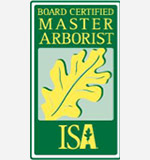How To Get Your Lawn Ready For Fall
Autumn is here and the cold temperatures and harsh weather of Winter are fast approaching. While you strive to enjoy the last of the sunshine and warm weather, lawn care is probably far from your mind. However, your fall lawn maintenance plan is crucial to achieving a lush, green lawn in the Spring. While grass grows more slowly in autumn, it’s also gearing up for its long dormancy in the winter ahead by absorbing nutrients and moisture. The efforts you make now will lead to a gorgeous and healthy lawn the following spring. Luckily, the process is relatively simple: just follow these tips.
Consider Aerating Your Lawn
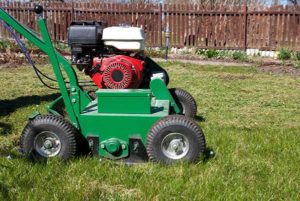 Over time, the soil underneath your lawn begins to pack down – especially in areas of your yard that see heavy use. Hard and dense soil prevents essential nutrients from reaching down to the roots, which is detrimental to the health of your lawn. Fall is an ideal time to aerate your turf.
Over time, the soil underneath your lawn begins to pack down – especially in areas of your yard that see heavy use. Hard and dense soil prevents essential nutrients from reaching down to the roots, which is detrimental to the health of your lawn. Fall is an ideal time to aerate your turf.
Aeration breaks up areas of soil compaction by removing plugs of earth and allowing water, air, and lawn treatments to penetrate past the surface to improve overall lawn health.
If you have a small lawn, you can easily aerate it with a garden fork by poking holes into the soil every two to six inches across your lawn. For larger lawns or for more effective results, your best bet is to rent a self-propelled, walk-behind aerator. These gas-powered machines easily punch holes into your lawn, making the aeration process efficient and effective.
Feed With Fertilizer
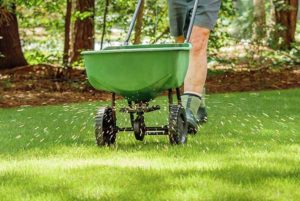
Ideally, you should apply fertilizer to your lawn twice each Fall. The first treatment should be done in either late August or early September, and the second one right before the first frost.
If you aerate your lawn during the fall, try to apply a nitrogen-rich fertilizer soon after to ensure the nutrients easily reach deep into the soil. Combining these two important tasks yields great results when the grass grows again.
Seed Bare Spots
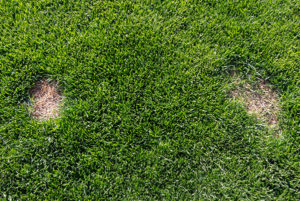
Most people wrongly assume that Spring is the ideal time to plant new grass, but most experts agree that it’s actually best to plant grass seed in the Fall – even if you’re just filling in some bare spots. During the Fall, the soil is still warm to allow for faster seed germination, but the cooling temperatures mean less stress on the new seedlings. There are also fewer concerns over crabgrass and other weeds popping up. Another bonus of Fall planting is your seed has both the Fall and Spring growing seasons to get established before the next Summer.
Seeding bare spots is a simple process. First, use a garden rake to loosen the soil and scratch away any thatch. Seeds won’t germinate unless they are touching the soil. Next, spread a thick layer of the seed, then lightly tamp it down. Finally, water the newly planted area and continue a regular watering schedule for the following two weeks. You can speed up the job and get great results by using a lawn repair mixture that contains fertilizer and mulch along with the grass seed.
Remove Leaves From Your Lawn

When the leaves are falling, blow or rake them away as often as you can. Even after the trees are bare, continue raking out leaves from corners and along structures where the wind tends to blow them. This step is critical to prevent the fallen leaves from becoming a soggy, decaying mess that will kill your grass. Raking also removes any build-up of lawn thatch that can block water absorption and play host to harmful insects.
Keep Mowing Your Grass
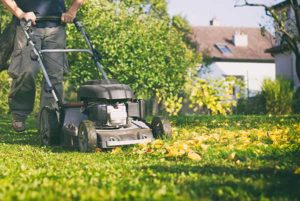
Once the grass-cutting season is over, you need to winterize your mower by performing the following maintenance steps:
- Inspect for damage
- Change the oil and spark plugs
- Clean the air filter
- Sharpen the blades
Proper care and regular maintenance help you spot problems early on to extend the life of your mower. Stay safe, and get a professional to perform the service if you are unsure what to do.
Water Your Lawn When Needed
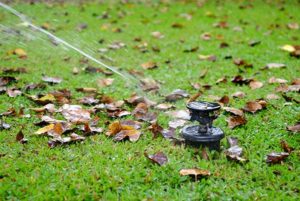
Pay close attention to the weather and use a rain gauge to measure how much water your lawn receives. One inch or more per week is sufficient moisture for most lawns. If your area doesn’t get adequate rain, you must continue to water your grass. Aim for soaking the area thoroughly every few days instead of more frequent, shallow watering. Adjust the amount of water you add as needed. If you received one-half inch of rain, just add another one-half inch of water to reach the desired overall amount. Start to reduce your watering as temperatures drop into the lower 30s. Once the ground freezes, the water cannot penetrate the soil.
Need Help Getting Your Lawn Ready For Fall?
Getting your lawn ready for Fall involves simple steps that pay off in a big way the following year. The timing and schedule of your Fall yard maintenance tasks determine how successful your efforts will be.
If you have any questions about preparing your lawn for Winter and getting a jump start on Spring, we would love to help you. Give us a call to get expert advice and product recommendations. Or request a Free Estimate of your landscape by a Ryan Pro to get personalized, professional lawn care services.







